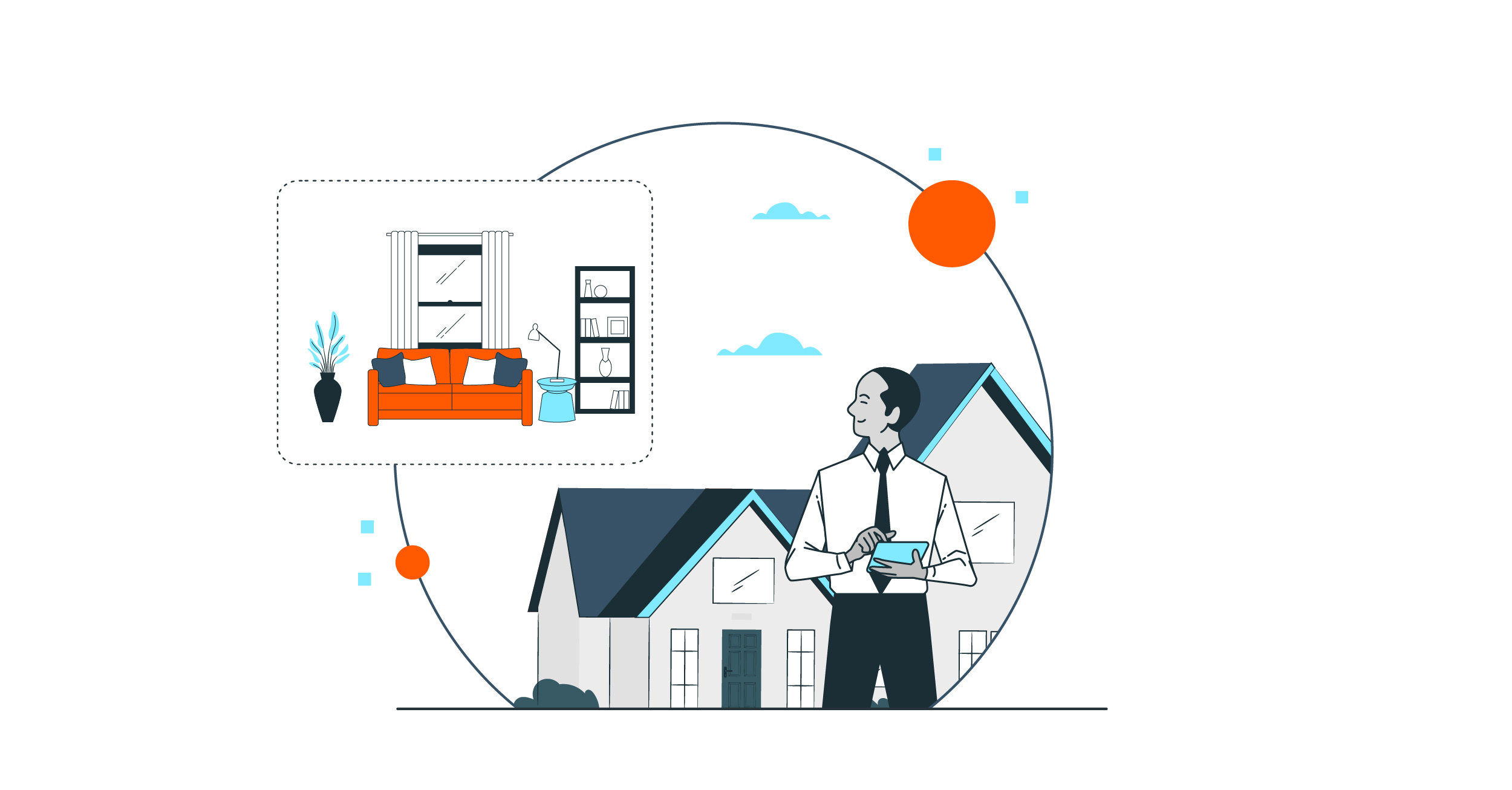
Choosing whether to provide a furnished or unfurnished property might seem like a minor consideration.
However, it can make a big difference to the sort of tenant you get, how easy it is to find a tenant, how much money you make, and the amount of hassle involved in running your property.
This article explains the key differences between renting furnished property and unfurnished, as well as things to consider when providing furniture.
|
Highlights:
|
What Should a Landlord Provide in an Unfurnished Property?
An unfurnished property will include enough fixtures, fittings and utilities to make the home habitable.
This usually includes:
-
Kitchen fixtures: for example, taps and a sink
-
White goods: like a cooker, fridge, freezer and washing machine
-
Bathroom fixtures: for instance, a shower and basin
-
Carpets or other types of flooring
-
Curtains rails or blinds
However, even this can differ between landlords. It’s a good idea to list exactly what you will provide as part of your unfurnished property in your tenancy agreement. This will help avoid disputes with your tenant over who has to replace things.
What Does Furnished Mean for Rental Property?
Furnished properties need to have everything someone needs to live comfortably. This usually means all the things listed for an unfurnished property, plus:
-
Sofas and/or armchairs
-
Dining table and chairs
-
Wardrobe/s
-
Drawers
-
Bed/s
What Does a Part-Furnished Property Include?
A part-furnished property contains everything a property needs to be habitable, plus a few basic comforts like a:
-
Bed
-
Free-standing wardrobe
-
Dining table
Landlords provide part-furnished properties as a middle option that is often more affordable than a fully furnished property.
Is Furnished Property Better?
Whether you furnish your property or not depends on the sort of tenant you want and the demands of your local housing market.
For example, families usually have their own furniture. If you want to attract this kind of tenant, providing an unfurnished property is a good idea.
It’s a good idea to perform some research on this. You can do this by looking at what is listed on lettings websites or asking your letting agent.
In general, furnished rentals tend to charge higher rents to reflect the convenience of the tenant not having to buy their own furniture and the additional costs incurred by the landlord.
Furnished rentals usually suit people who are only there for a short period. This could include:
-
People looking for short-term lets
-
Those looking to be closer to work during the week
-
Corporate tenants who require a property for staff/clients
-
Overseas tenants
-
Young professionals looking to live in high-ticket areas
Apartments or flats are often furnished, because they appeal to young people without kids who are saving to move to a larger property.
On the other hand, unfurnished properties tend to attract longer-term tenants like families. Houses tend to be furnished because families often already have their own furniture.
Also, because they usually plan to stay in the property for longer, they prefer to give it a personal touch. One way of doing this is to use their own furniture.
Furnished property pros
✔️You can get a higher monthly rent
✔️Attract tenants who don’t own things or want to buy themselves
✔️Neither you nor your tenant needs to move as much in or out
✔️Furnishings can be reused
✔️Some of the furniture replacement costs are tax-deductible
✔️Generally easier to market because the tenant can imagine themselves living there
Furnished property cons
❌Higher costs and admin relating to maintaining and replacing furniture
❌Higher insurance premiums as you have more to insure
❌Put off longer-term tenants who are more likely to own furniture
❌You might have to store some furniture if the tenant doesn’t want it
Unfurnished property pros
✔️Lower initial costs
✔️You don’t have to buy or install furniture yourself
✔️Fewer ongoing costs and work over fixing or replacing furniture
✔️Less insurance required
✔️Will likely attract longer-term tenants
✔️You don’t need to clear the property if you choose to sell
Unfurnished property cons
❌Unfurnished properties generally generate lower rental income
❌Less appeal to short-term tenants who don’t want to own furniture
❌Longer vacancy periods because it can take longer to find suitable tenants
How Does Furnished Property Impact Insurance?
If you provide an unfurnished property, you will only need buildings insurance for your new property.
But if you provide a furnished home then it’s a good idea to get contents insurance too. This will cover repairing or replacing damaged furniture.
You will need to pay extra for this insurance, but it is worth having to avoid financial shocks.
Furnished Property Regulations
Fire regulations are another important consideration when providing a furnished property.
Any furniture you provide should state on the label that it meets the Furniture and Furnishings (Fire) (Safety) Regulations 1988.
Failure to comply with this could result in a fine of £5,000 per non-compliant item. In more serious cases, you could even face a prison sentence.
Landlords also need to ensure that all electrical appliances they provide are safe to use. The best way to do this is to have an electrician perform a portable appliance test (PAT) on them.
Who Is Responsible for Furniture in a Furnished Property?
Landlords are expected to replace furnishings that suffer wear and tear - in other words, minor damage caused over time from reasonable everyday use.
However, tenants are expected to return a property to its original condition when they end the tenancy. If the tenant damages your furniture, either through misuse or by accident, you can ask them to pay to replace it.
Your tenancy agreement should have an inventory of everything in the property, including the furniture and the condition it is in. You should also take photos of everything, but this does not have to be included with the tenancy.
Five Tips for a Desirable Furnished Property
If you plan to spend extra money on furnishing your property, it’s important to get tenants in there and start earning rent as soon as possible.
Here are five tips to make your furnished property more attractive to tenants:
Provide easy-to-clean furniture
Some tenants won’t look after your furniture as well as you would like them to. Even if they do, soft furnishings naturally become grubby over the years, so you’ll need to clean them regularly. Make the cleaning process easier by choosing dark-coloured materials that don’t show dirt and are hardy and washable.
Keep it plain
Don’t try to impose your personal style on the property. People have different tastes and if a potential tenant doesn't like yours, they will be put off renting your property. Most tenants want a blank canvas that they can add their own style to.
It’s a good idea to use plain, simple colours and styles that appeal to the widest range of people.
Easily replaceable
Don’t provide anything too expensive or unique. If you do, you could end up wasting your money if it gets broken and you might struggle to replace it. Ensure that everything you provide can be purchased off the shelf at your local DIY or homeware store.
Replace regularly
Replacing furniture regularly keeps tenants happy, keeps your property looking nice, and avoids breakages. The Tenancy Deposit Scheme says landlords should replace each item of furniture about every seven years.
Provide a tool kit
Leave a simple tool kit in the house so tenants can fix basic problems themselves if they want to. Ask them not to repair anything that could put their health and safety at risk. Encourage them to contact you if they are not confident or don’t want to repair things.
Use Technology to Keep on Top of Furniture Repairs
The furniture in furnished properties needs to be looked after - which means these properties often require additional maintenance and inspections.
You can reduce the amount of hassle involved in doing this by using a digital platform like EVO to manage your property maintenance.
Our platform brings together tenants, landlords and tradespeople, allowing you to schedule inspections and arrange repairs in a convenient way for you and your tenants.
You can also manage your compliance to ensure that your tenants (and your reputation) are safe.
Our easy-to-use digital solution features:
Online dashboard: All your people, places, repairs, and service history all in one place, with a real-time calendar, messaging, and secure document storage.
Helpdesk: There to help with all repair and planned maintenance needs fast.
Repairs: Certified trades available 24 hours a day, ensuring a fast response and quality workmanship.
Reminders: Ensuring that nothing falls through the cracks.
Service history: All jobs and services are logged and easily accessible, with completion notes and images.
Compliance: Gas safety compliance, electrical testing and more, with digital records and service reports all in one place.
Emergency cover: Providing trustworthy 24/7 emergency services in case of serious issues.
Get in touch to find out how we can help you manage your inspection and repairs more effectively.


